Text
It’s a long weekend for a holiday I don’t really celebrate, so I’m once again spending my free time on the ideal activity: looking at sea monsters. This time they’re from the non-standard art style variant of Der naturen bloeme (British Library Add MS 11390). The fish section starts at f.49v & I highly recommend checking it out! It’s a cornucopia of delights and no post could possibly do it justice since there are perfect images on literally every page. That being said, here are some personal highlights:
💪 ¯\_(ツ)_/¯
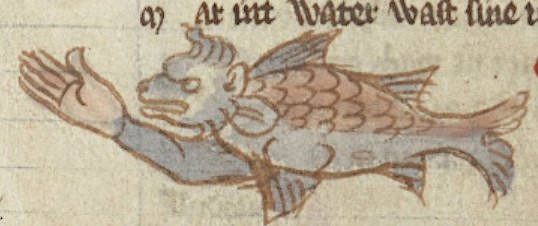
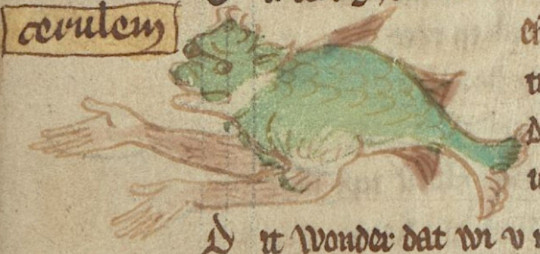
2 kinds of dolphins, both equally valid (ocean & river for people who aren’t familiar with platanista or are struggling with the script)

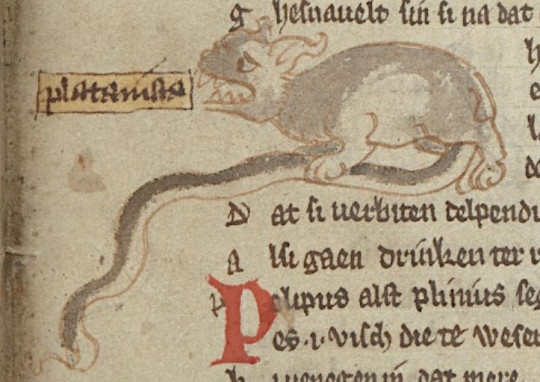
naut...il..us?
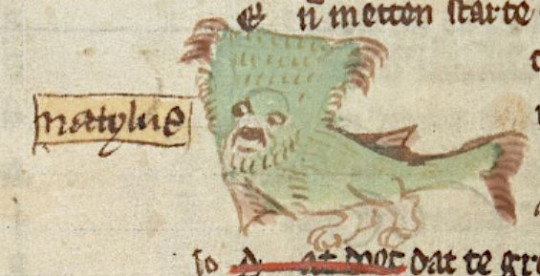
polyp

tragically blurry sea-deer
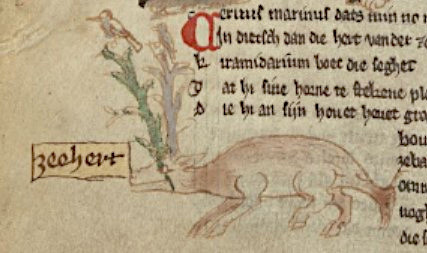
orca with just the wiggliest mouth

& ziphius

I haven’t been referencing the standard illustrations, but it’s vital everyone know that in the original the ziphius looks like this

[KB KA 16, fol.111r]
#sea monsters#insert your own meme about the benefits/detriments of being a marine biologist#I'll get back to asks soon I just haven't been in the mood for focused research lately#sorry to everyone waiting!
697 notes
·
View notes
Text
The Shape of Water (1280 CE)
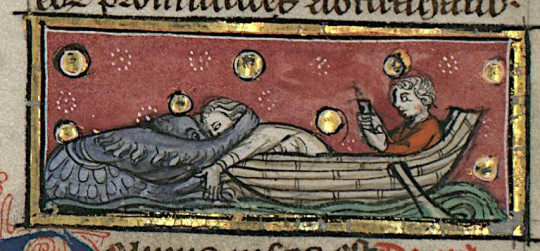
[Bibliothèque municipale de Valenciennes, Ms 0320, fol. 118r]
#sea monsters#to be clear this is supposed to be a squid or possibly an octopus dragging someone overboard
515 notes
·
View notes
Text
From the people who brought you the winged crocodile comes another blockbuster effort at putting bird parts where bird parts absolutely should not be: the beaked hippopotamus

[Bibliothèque municipale de Valenciennes, Ms 0320, fol. 116r]
435 notes
·
View notes
Text
Incredible work!
[If you’re the kind of person who follows this blog, you’ve probably already seen @draconym‘s Beaft Maker, but it’s a lot of fun so there’s the link again just in case]
Attempting some medieval beafts courtesy of this Picrew beaft creator:
A Sea Turtle:
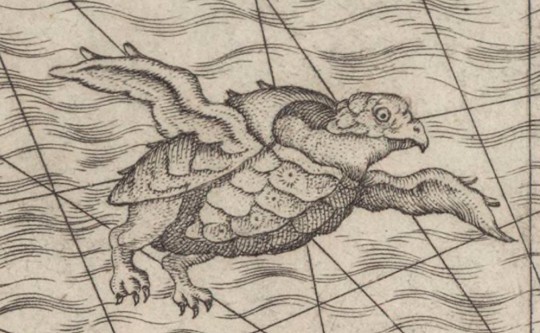

A Serpent:


A Crocodile (obviously):

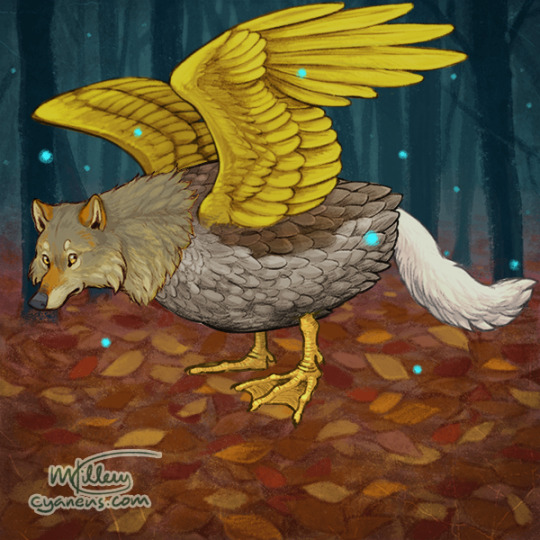
And a Cat-Snail:


(manuscript images courtesy of @historieofbeafts)
3K notes
·
View notes
Text
While we’re on the subject of birds, here are some of the faces a swan can make:
Belligerent
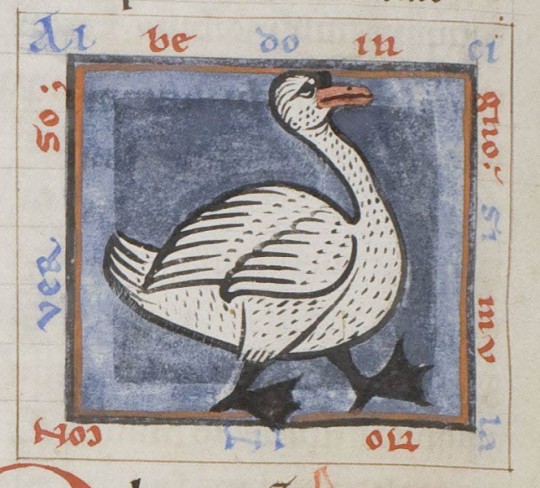
[Grootseminarie Brugge, MS. 89/54, fol. 81v]
Belligerent
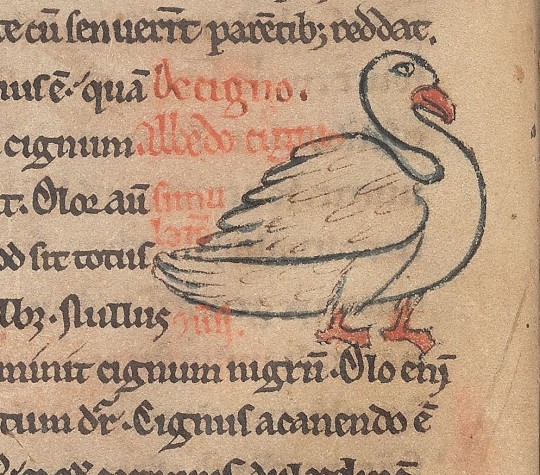
[Yale University Library, Beinecke MS 189, fol. 8v]
Belligerent
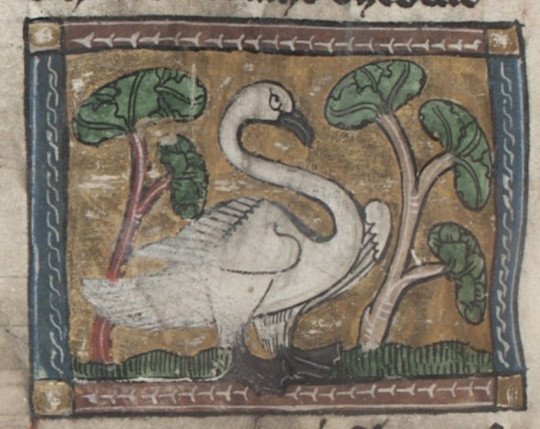
[KB KA 16, fol. 79v]
Belligerent

[Bodleian Library MS. Ashmole 1504, fol. 036v]
Belligerent

[Bodleian Library MS. Bodl. 764, fol. 65v]
& full of teen angst
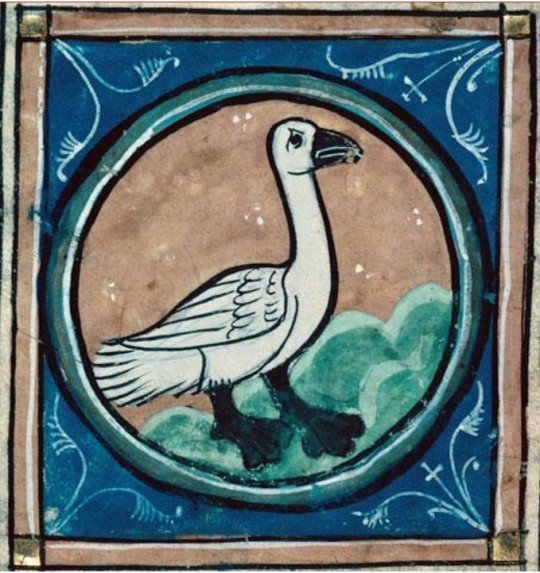
[Chalon-sur-Saône, Bibl. mun., ms. 0014, f. 071v]
#birds#swans#one of the rare occasions where everyone involved seems like they've seen the thing they're drawing
4K notes
·
View notes
Text
I’ve been reading the Cambridge translation of Isidore of Seville’s Etymologies for comparison purposes and it’s providing some great quotes about birds.
General Wisdom
“No one can discover how many kinds of birds there are.”
On Owls
“This bird is not found on the island of Crete, and if it should come there from somewhere else, it immediately dies.”
“a wild bird, loaded with feathers, but always constrained by heavy sluggishness; it is active among tombs day and night, and always lingers in caves […] when it has been seen in a city, they say that it signifies desolation.”
A Problem Specific to Roosters, I Guess
“The rooster’s limbs, some people say, are consumed if they are mixed with molten gold.”
The Bravest Bird
“The hawk (accipiter) is a bird armed more with spirit than with talons.”
How Woodpeckers can Ruin a Construction Project
“People say this bird has a certain supernatural quality because of this sign: a nail, or anything else, pounded into whatever tree the woodpecker has nested in, cannot stay there long, but immediately falls out.”
Cursed Hoopoe Life Hacks
“Anyone who anoints himself with the blood of this bird and then goes to sleep will see demons suffocating him.”
& Key Issues in Theology
“It is a great sin to believe that God would entrust his counsels to crows.”
1K notes
·
View notes
Text
Are you tired of not having an answer when people ask about your favourite 12th century image of a basilisk? Because boy do I have a solution for that specific problem:

[Harvard University, Houghton Library, MS Typ 101, fol. 14v]
295 notes
·
View notes
Text
Medieval Crocodile Concept #2565554: body of a snake, head and legs of a dog, the gentlest eyes, ...wings?

[Chalon-sur-Saône, Bibl. mun., ms. 0014, f. 079v]
+ traditional close-up of the face you make when you’re being eaten by a crocodile
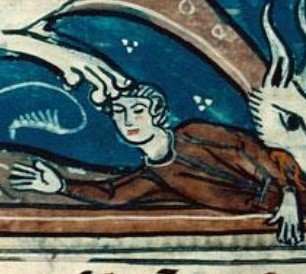
2K notes
·
View notes
Text
always cool to see people drawing medieval animals!
youtube
@historieofbeafts
#user generated beafts#also when I went on hiatus my mentions were completely unusable due to ray-bans#so I'm thrilled they're functional again & sorry if I missed anything
90 notes
·
View notes
Note
Is there a reason for the persistent association between scorpions, crabs, and basil?
[It's been long enough this probably needs a link to the original scorpion post for context]
As far as I'm aware, the association between scorpions and crabs comes from straightforward physical similarities (pincers, exoskeletons, etc.). Though when Ovid gives a list of animals that grow from decay in Book 15 of the Metamorphoses he says scorpions come specifically from crabs that have been buried without their claws, which is the opposite of what I'd expect.

[from the 1567 Golding translation, which gets overhyped as one of Shakespeare's influences, but was still an important text in the English Renaissance. also cleas=claws & writhen=twisted]
The association with basil is more complicated. The short version is that the first confirmed Greek mention of basil comes from a physician called Chrysippus (~4th c. BCE). His works were lost, but enough survives in later texts to know that he thought basil was extremely dangerous and unfit for human consumption, but doesn't seem to have mentioned scorpions.
Africa and Asia have a much longer history with basil, and when it does start to get linked with scorpions in classical texts there’s often an accompanying reference to “African” practices. Which isn’t enough to establish cross-cultural influence, but for the purposes of this blog I think it’s okay to speculate that a preexisting link between basil and scorpions + the Greek & Roman medical practice of treating scorpion stings with a mixture of basil, wine and vinegar + the fact that scorpions are frequently found in the kinds of places where basil grows + a cultural belief in the spontaneous generation of small animals made the idea of scorpions growing from basil seem pretty reasonable.
That’s a lot of words without a primary source, so here’s internet favourite Pliny the Elder providing an example of what I’m talking about:

Brief digression, but the highlight of Pliny’s basil facts actually has nothing to do with scorpions. It’s this Totally Normal Gardening Tip:

Obviously it’s fun to imagine a world where this caught on and HGTV stands for Hostile Gardening Television, but it might be even more fun to imagine someone at a fair asking a prizewinning vegetable grower what their secret is and being told “ancient wisdom: swear at yer zucchini.” /end digression
This is already a pretty long post, but while I’m on the subject I can’t not talk about the ‘sniffing too much basil will give you brain scorpions’ urban legend popularized in the 16th-17th centuries. To start with, here are two 17th c. summaries that also give a pretty good idea of the Basil Discourse ™ at the time:


[Culpeper’s The English Physician (1652)]

[Topsell’s History of Four-footed Beasts and Serpents (1658)]
Point form notes because there’s a lot to unpack:
Billingsgate is a fishmarket famous for vulgar language
Non nostrum inter nos tantas componere lites is Virgil reference for “above my pay grade”
Dr. Reason is an allegorical figure representing logic/common sense
The link with basilisks comes from dubious folk etymology, but still probably contributed to basil’s bad reputation
Hollerius is the Latin name for the French physician Jacques Houllier, and I went through his De morborum internorum curatione, liber I (1572) & De morbis internis, libri II (1589) in hopes of finding more information about Brain Scorpion Patient Zero
He doesn’t provide any
Seriously
Each volume contains a one (1) sentence summary saying that an Italian man grew a scorpion in his brain and then died as a result of smelling too much basil
That’s it
The Gesner example comes from a treatise on scorpions published posthumously as part of Vol. 5 of his Historiae animalium (1587)
It also doesn’t provide any information beyond “an apothecary told me about a French girl who died after smelling basil and turned out to have a brain full of scorpions”
Obviously the real reason for the vagueness is because these are, at absolute best, examples of the false cause fallacy, but I still have a pressing need to know how patients’ basil-sniffing habits entered the medical record
Like, where would you even get that information?
Catch me learning necromancy so I can ask 16th c. physicians some pointed questions about brain scorpion diagnostic criteria, I guess
After all that, it seems fitting to conclude this post with someone who has no problem describing exact methodology: the scientist and mystic Jan Baptist van Helmont, who provides a recipe for growing scorpions from basil in his Oriatrike, or Physick Refined (1664)


I mean, what can you say to that except

He also has a recipe for growing mice by leaving a dirty shirt in a container of wheat:

#asks#scorpions#ye olde heath tips#ye olde body horror#to give van Helmont credit#his experiments are some of the only things on this blog you can try at home#they won't work and they're a little unhygienic#but they aren't unethical or wildly unhealthy!#the bar is extremely low#but he did clear it
201 notes
·
View notes
Text
There are a lot of things to love about these 14th c. Italian birds (in order: hawk, ostrich & crane), but my absolute favourite is the total disregard for formatting:
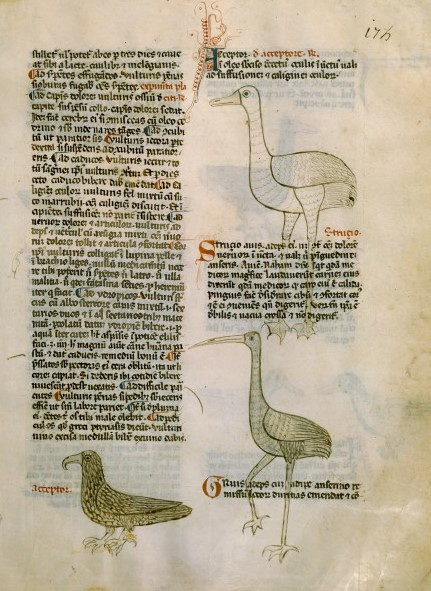
the manuscript (BnF Latin 6823) also contains some stunned looking pigeons:

an example of how easy it is to start drawing a swallow and accidentally end up with a fish:

and the real reason I’m making this post, the pinnacle of scientific illustration, an image that stopped me dead in my tracks:

egg
#birds#I'm also going to tag this#sea monsters#because of the merswallow#which is an animal that should exist
2K notes
·
View notes
Text
Slightly more scholarly update: the text here is the short version of Pierre de Beauvais’ Bestiaire & the other chapters have normal illustrations, so this may in fact be a whale (????)
Also, I just looked it up in McCulloch’s Mediaeval Latin and French Bestiaries & she said this:

so apparently this is an instance of individual creativity that has baffled scholars for almost 60 years
Usually when I encounter unidentifiable animals it’s either because of physical damage to the manuscript or because something generically animal-shaped has been drawn in a location where the text doesn’t provide any clues for a more specific identification. But sometimes a genuine mystery turns up, like this 13th c. french miniature:

Key points:
five heads
but not where you’d expect
two of them are birds
confidently placed in a chapter about whales
definitely not a a whale
who is she
[BnF, Nouvelle acquisition française 13521, fol. 27]
7K notes
·
View notes
Text
Usually when I encounter unidentifiable animals it’s either because of physical damage to the manuscript or because something generically animal-shaped has been drawn in a location where the text doesn’t provide any clues for a more specific identification. But sometimes a genuine mystery turns up, like this 13th c. french miniature:

Key points:
five heads
but not where you’d expect
two of them are birds
confidently placed in a chapter about whales
definitely not a a whale
who is she
[BnF, Nouvelle acquisition française 13521, fol. 27]
#no idea what to tag this#history mysteries#unidentified beastlike object#two front heads and a face on the tail suggests chimera#but nothing else about this image does
7K notes
·
View notes
Note
hey! i know you're super busy right now and this isn't urgent at all, but i'm designing a tattoo sleeve for myself completely of medieval animal drawings and was wondering if you have some helpful sources for that?
I know you said this isn't urgent, but it's been long enough I feel like I should apologize for the delay!
If you're still looking for sources, I’d recommend the Bibliothèque nationale de France’s database of illuminated manuscripts, which is great as long as you have either a rudimentary knowledge of French or a willingness to look up animal names etc. in a translation dictionary. Its most useful feature is the ability to search by caption/légende, so if you have a specific animal in mind you can pretty easily find every image of it in the collection. If you aren’t at that stage in the planning, you can also just search for a common bestiary animal, like a lion, and browse until you find a manuscript with an art style you like.
For a more general overview, searching for bestiaries in the Digital Bodleian collection will get you a good range, including some big names like the Ashmole Bestiary.
I personally find the British Library collection kind of unwieldy for casual browsing, so here’s a list of the animal-related manuscripts I can think of off the top of my head:
Harley 3244
Harley 4751
Royal 10 A VII
Royal 12 C XIX
Royal 12 F XIII
Sloane 3544
Add MS 11390
There are a ton of other sources out there, but I don’t want this list to get too overwhelming, so I’ll just link three more of the big ones & hope something here helps!
The Aberdeen Bestiary
The Bestiary of Anne Walshe
Der naturen bloeme
133 notes
·
View notes
Text
The award for Best Symbolic Sea Monster Riding on a 16th Century Map still goes to Fernado Bertelli’s 1565 Universale descrittione di tutta la terra conosciuta fin qui, which features Bold Fortune windsurfing on the back of a truly indescribable fish & is singlehandedly responsible for changing my understanding of her role to ‘Goddess of Extreme Sports’
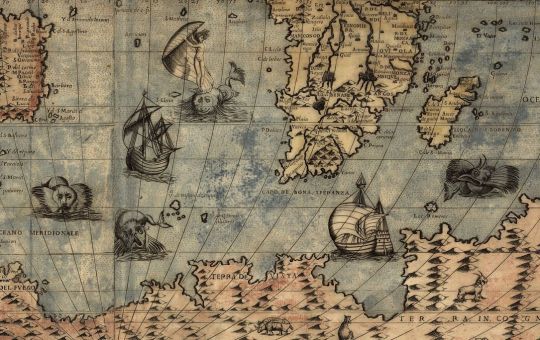
+ close up
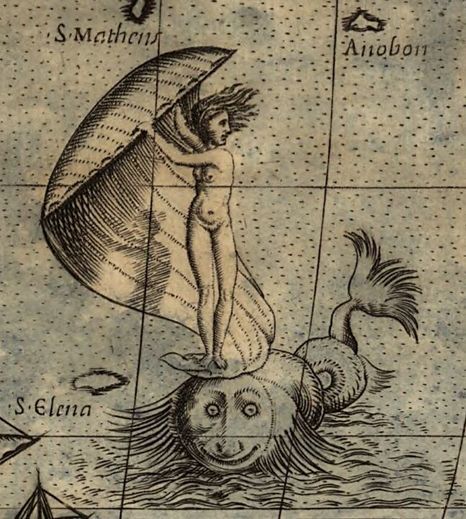
#sea monsters#my favourite part of this is there's no reason to have a sail when you're already riding a fish#and yet
583 notes
·
View notes
Text
I got my second shot & I’m taking it easy for a day or two, which means it’s time for the ultimate relaxation reading: 16th century maps! In this case, Abraham Ortelius’ Theatrum Orbis Terrarum, usually described as the first modern atlas. It was originally published in Antwerp in 1570, but I’m using the 1571 edition from the Koninklijke Bibliotheek collection (also available at Wikimedia Commons).
Probably no one will be surprised to hear that when I say “looking at maps” I mostly mean “looking at decorative sea monsters that happen to be located on maps,” but before we get to the fishy friends here’s the world map that opens the book, just because it’s kind of cool to see what has and hasn’t changed over the last 450 years.

Now that that’s out of the way, choose your fighter:
a) fringed sea-gnome

b) a letter opener

c) duck horse, or dorse

d) absolute unit
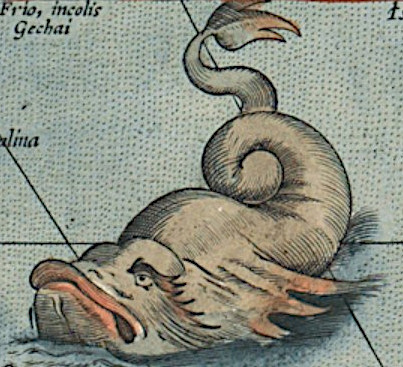
A key feature of this edition is that all the fish have easily some of the faces I’ve seen:

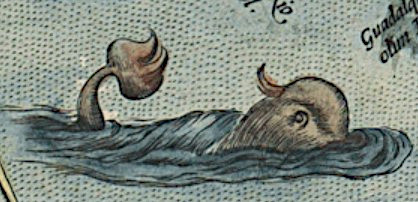


This one gets its own section because when I first saw it I thought the tail was a second head, and I can’t get over this duck-billed affront to nature serving not one but two of the most disgusted expressions I’ve even had the honour of beholding:

On one hand, the custom of depicting monarchs and powerful figures as Neptune was meant to symbolize dominion over the waves and is directly tied to imperialism
On the other hand, *gestures to entire sea monster*
On the third hand I had installed specifically for hypotheticals, this is so much funnier than any current trends that I think we should bring it back as a way of depicting celebrities and cultural icons? As long as you remove the trident/laurels/emblems there’s no reason being transported by sea monsters couldn’t have completely un-imperial symbolism ¯\_(ツ)_/¯
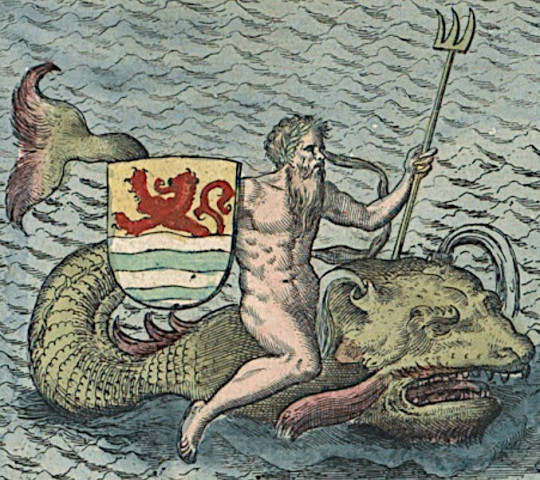
One of my many ideas that no one else appreciates is a band composed entirely of the weirdest musical grotesques from historical documents. Would they be holograms? animatronics? a cross between Medieval Times and Chuck E. Cheese? an avant garde boyband concept? I don’t know, but I do know I dream of a world where this guy goes platinum:

Even more faces:
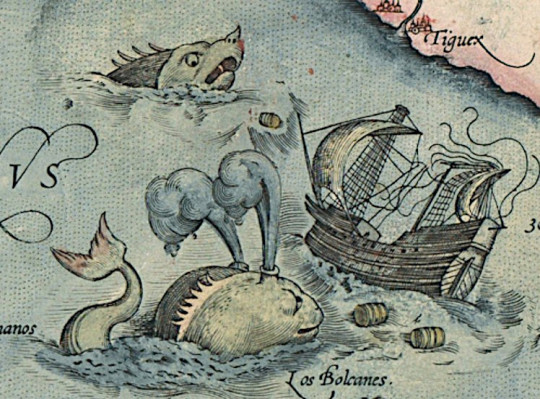
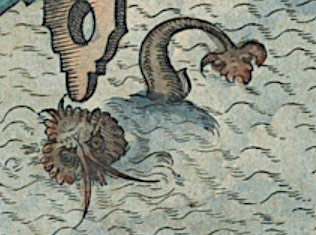

#sea monsters#full disclosure: I wrote this several days ago while extremely feverish#and waited until today to post so I could double check that it wasn't totally incoherent
555 notes
·
View notes
Text
Thanks for the guesses! In the immortal words of Emily Dickinson

I’m still too swamped by Seasonal Busyness ™ to really be around on tumblr, but I saw this visionary depiction & couldn’t resist another round of Who’s That Pokemon Beaft, so if you have any guesses what animal this is meant to be please reblog & put them in the tags :)
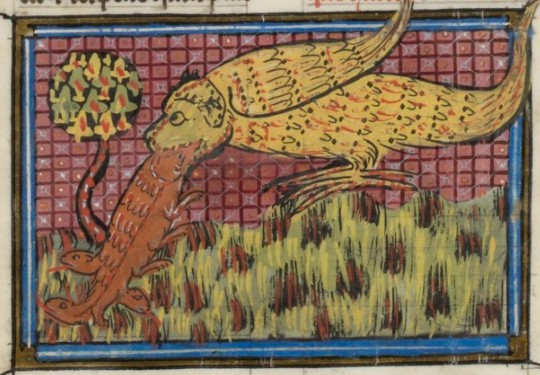
[BnF, Français 15213, fol. 84r]
#crocodiles#my favourite bird!#congratulations tumblr user omgellendean for getting this one#the red creature is a hydra (noted enemy of crocodiles)
714 notes
·
View notes